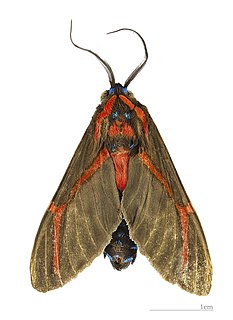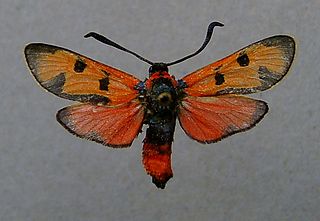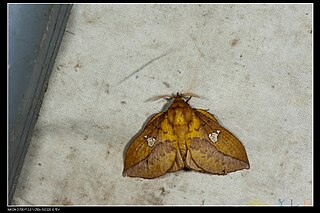
The Arctiini are a tribe of tiger moths in the family Erebidae.

The Phaegopterina are a subtribe of tiger moths in the tribe Arctiini, which is part of the family Erebidae. The subtribe was described by William Forsell Kirby in 1892.

Himerarctia is a genus of moths in the family Erebidae. The genus was described by Watson in 1975.

Viviennea is a genus of moths in the family Erebidae. The genus was described by Watson in 1975.
Euthrix is a genus of moths in the family Lasiocampidae. The genus was erected by Johann Wilhelm Meigen in 1830. It includes the following species:

Zygaena laeta, the bloodword burnet, is a moth of the family Zygaenidae. It is found in Central and South-Eastern Europe.In Z. laeta the collar and patagia as well as the apical half of the abdomen are red: also the wings are testaceous red except some black spots on the forewing. Larva of light bluish green, with while dorsal and lateral lines, along which there are blackdots. Pupa yellow, anteriorly dark brown, in a whitish cocoon. The wingspan is 26–34 mm.
Capsula laeta, the red sedge borer, is a moth of the family Noctuidae. The species was first described by Herbert Knowles Morrison in 1875. It is found in North America, including Ohio, Illinois, New Jersey and Ontario.
Chersotis laeta is a moth of the family Noctuidae. It is found in number of isolated populations from Greece to the Caucasus, Turkey, Lebanon, Israel and Syria.

Himerarctia docis is a moth of the family Erebidae. It was described by Jacob Hübner in 1831. It is found in French Guiana, Guyana, Brazil, Colombia, Peru and Bolivia.
Himerarctia griseipennis is a moth of the family Erebidae. It was described by Walter Rothschild in 1909. It is found in Brazil.
Himerarctia viridisignata is a moth of the family Erebidae. It was described by Watson in 1975. It is found in Brazil.

Hypercompe laeta is a moth of the family Erebidae first described by Francis Walker in 1855. It is found in Panama and Venezuela.
Termessa laeta is a moth in the subfamily Arctiinae. It was described by Francis Walker in 1856. It is found in Australia, where it has been recorded from the Australian Capital Territory, New South Wales, Queensland, South Australia, Victoria and Western Australia.

Virbia laeta, the joyful holomelina, is a moth in the family Erebidae. It was described by Félix Édouard Guérin-Méneville in 1844. It is found in North America from New Brunswick south to Florida and west to Minnesota and south to Texas. The habitat consists of pine woodlands.
Periploca laeta is a moth in the family Cosmopterigidae. It was described by Ronald W. Hodges in 1962. It is found in North America, where it has been recorded from Florida, Arizona, Illinois, Ohio, Quebec and West Virginia.
Erora laeta, the early hairstreak, is a butterfly of the family Lycaenidae. It is found in eastern Canada and the United States. The habitat consists of deciduous and mixed woods.

Euthrix laeta is a moth of the family Lasiocampidae first described by Francis Walker in 1855.
Lambdina laeta is a species of geometrid moth in the family Geometridae. It is found in North America.








